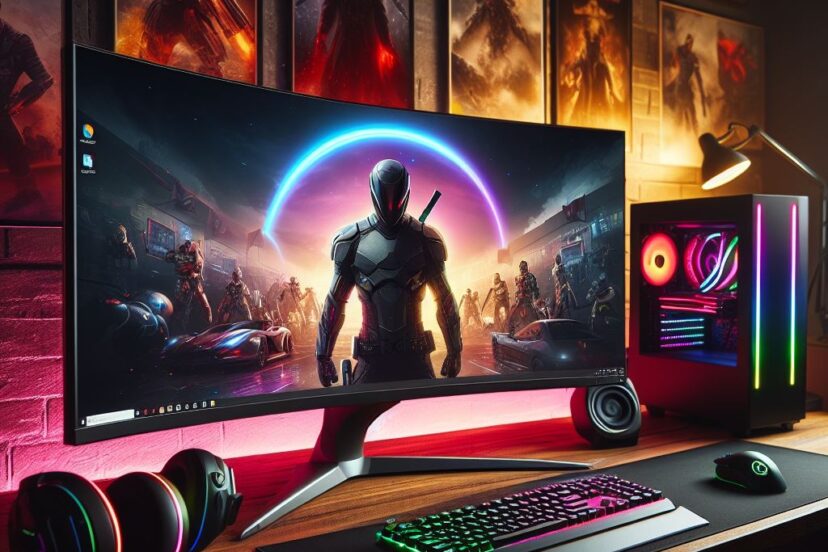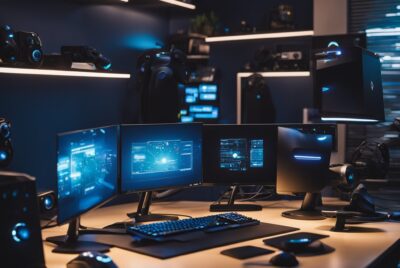120Hz Gaming Monitor – The Ultimate Gaming Revolution
*We may earn a commission for purchases made using our links. Please see our disclosure to learn more.
120Hz Gaming Monitor: Enhance Your Gameplay Experience
Gaming monitors are essential for any gamer serious about performance. With the market filled with many options, choosing the right one can be overwhelming. One popular category is the 120Hz gaming monitor. These monitors offer a smoother visual experience by refreshing the screen 120 times per second, making fast-paced games more seamless and enjoyable.
When looking at 120Hz gaming monitors, there are a few critical factors to consider. Screen size can impact your gaming experience, with larger screens offering more immersive visuals. Response time is also important, as a lower response time reduces lag and ghosting effects, providing clearer image quality. Connectivity options like HDMI and DisplayPort ensure your monitor is compatible with your gaming setup.
We carefully examined and tested several 120Hz gaming monitors to help you find the best options for an enhanced gaming experience.
Top 120Hz Gaming Monitors
I have chosen some of the best 120Hz gaming monitors available right now. These monitors offer top-notch performance for gaming enthusiasts.
Sceptre 30-inch Curved Gaming Monitor
This monitor is a great choice for gamers looking for a large, immersive display with high refresh rates.
Pros
- Great refresh rate for smooth gaming
- Wide screen provides an immersive experience
- Built-in speakers offer decent sound
Cons
- Limited resolution compared to other monitors
- Built-in speakers could be better
- Needs space due to its size
I was really impressed by the Sceptre 30-inch Curved Gaming Monitor‘s design. The curved screen pulled me into the game, making it feel more real. The slim bezels also added to the sleek look of the monitor.
The high refresh rate was a standout feature. Games looked super smooth and responsive. This feature is especially useful for fast-paced games where quick reactions matter. The AMD FreeSync technology also helped to eliminate tearing and stuttering, making the gaming experience even better.
Despite the many positives, I found the resolution a bit lacking. For its size, I’d have liked a higher resolution for sharper images. Also, while the built-in speakers are convenient, they don’t deliver the best sound quality. If you have the space and budget, external speakers or headphones might be a good addition.
Acer Nitro 27″ WQHD Gaming Monitor
This monitor is a fantastic choice for competitive gamers who need a smooth gaming experience.
Pros
- Excellent 1440p resolution
- High refresh rate up to 180Hz
- AMD FreeSync Premium reduces screen tearing
Cons
- Built-in speakers are underwhelming
- Bulky design
- Average HDR performance
I tried the Acer Nitro 27” WQHD Gaming Monitor, and it truly elevates gaming. The 1440p resolution brings sharpness and detail that make every game look stunning. The high refresh rate of 180Hz is a game changer, delivering incredibly smooth movement.
With AMD FreeSync Premium, I noticed a significant decrease in screen tearing and stuttering. This feature alone makes fast-paced games much more enjoyable. The design might be a bit bulky for some, but it saves desk space by allowing for multiple monitors side by side.
The built-in speakers, while convenient, don’t offer great sound quality. If you’re looking for superior audio, external speakers or headphones are a better choice. Also, the HDR performance could be better, but overall, this monitor provides a strong gaming experience for its price.
Check more about it here.
ASUS TUF Gaming 32″ Curved Monitor
A great choice for gamers looking for a large, immersive screen with top-notch performance.
Pros
- Smooth 165Hz refresh rate
- Clear visuals with Extreme Low Motion Blur
- FreeSync Premium reduces tearing
Cons
- Takes up a lot of desk space
- Built-in speakers are average
- No USB ports
This ASUS TUF Gaming 32″ curved monitor has impressed me with its incredible performance. The 165Hz refresh rate ensures that every game runs smoothly without any lag. It’s especially great for fast-paced games where every frame counts.
One of the standout features is the Extreme Low Motion Blur technology. It really helps in making the visuals crisp and eliminates any motion blur. Whether I’m playing an action-packed shooter or a racing game, the image quality is consistently sharp.
The FreeSync Premium technology is also a big plus. It keeps the screen free of tearing and stuttering, which makes the gaming experience all the more enjoyable. The curve of the monitor adds to the immersive experience, pulling me right into the action.
On the downside, the monitor is pretty large. It takes up a lot of space on my desk, so make sure you have enough room. Also, the built-in speakers are okay but not great. If sound is important to you, a separate set of speakers or headphones might be necessary. Additionally, the absence of USB ports can be a minor inconvenience for connecting extra peripherals.
In summary, this monitor is a powerful tool for any gamer. Its performance features far outweigh the few drawbacks, making it an excellent addition to my setup.
Deco Gear 35” Ultrawide Gaming Monitor
This monitor offers an excellent balance of gaming performance and professional productivity with its vibrant display and immersive experience.
Pros
- Excellent color accuracy and vibrancy
- Smooth 120Hz refresh rate for gaming
- Wide, curved screen for better immersion
Cons
- Large size may not fit all desks
- Limited to QHD resolution
- Potential difficulties with setup and adjustments
I was quite impressed by the vibrant colors and sharp details when I first used the Deco Gear 35” Ultrawide Gaming Monitor. It supports a wide color gamut, making both gaming and professional tasks like photo editing a pleasure. The 3440 x 1440 resolution offered clear images, though it isn’t 4K, which might be a limitation for some.
Gaming on this monitor is a delight due to its 120Hz refresh rate and 1ms response time. These features ensure smooth and responsive gameplay, allowing me to enjoy competitive gaming without any screen tearing or lag. The curved design of the screen helps to provide an immersive experience, making me feel quite enveloped in the action.
One thing to consider is the setup process. The monitor’s large size means you need ample desk space, and adjusting settings using the built-in controls can be somewhat tedious. Despite these minor drawbacks, the overall performance and stunning visuals make it a worthy investment for both gamers and professionals alike.
LG UltraGear 27-Inch Gaming Monitor
If you’re an avid gamer, this monitor’s fast response time and vibrant display colors make it a top-notch choice.
Pros
- Sharp and vivid visuals
- Fast 1ms response time
- Adjustable stand for ergonomic comfort
Cons
- Noticeable bezels for some users
- Requires a good graphics card for optimal performance
- On the pricier side
Gaming on the LG UltraGear 27-Inch Gaming Monitor has been a game-changer for me. The colors are vibrant, making every game feel more alive. With a 1ms response time, I experienced no lag, keeping me on top of my game.
One of the best features is the adjustable stand. Being able to tilt and pivot the monitor helped me find the perfect angle, reducing neck strain during long sessions. Its G-Sync compatibility also means smoother gameplay without screen tearing.
On the downside, the noticeable bezels might be a bit distracting for some. Also, you’ll need a solid graphics card to get the most out of it. Despite the higher price, the quality and experience it delivers justify the investment.
ASUS TUF Gaming 28” 4K 144HZ Monitor
This monitor is an excellent choice for gamers who want a high-refresh 4K experience.
Pros
- Fast refresh rate makes gameplay smooth.
- Impressive color accuracy and brightness.
- Easy setup with versatile connectivity options.
Cons
- Larger footprint may take up desk space.
- The price might be on the higher side.
- Stand adjustments could be more flexible.
I recently tried out the ASUS TUF Gaming 28″ 4K 144Hz monitor, and it truly delivers on its promise of smooth and crisp visuals. The colors pop, and with a 144Hz refresh rate, every frame feels as clear as reality. It’s fantastic for both casual and competitive gaming.
Setting up the monitor was straightforward, and the variety of ports made connecting my devices hassle-free. The HDMI 2.1 support is a significant plus, especially for those using next-gen consoles. I appreciated the seamless performance with NVIDIA G-SYNC and AMD FreeSync, reducing any screen tearing during intense gaming sessions.
One thing to note is the size of the monitor. It is quite large, which is great for immersion but could dominate smaller desks. While the stand is stable, it offers limited adjustment options. Overall, despite these minor issues, the ASUS TUF Gaming monitor is a solid investment for any serious gamer.
Buying Guide
When choosing a 120Hz gaming monitor, there are a few key features to look for.
Resolution
Look for at least 1080p resolution, though 1440p or 4K may offer a better experience. Higher resolution means sharper images.
Panel Type
IPS, TN, and VA are the main types of panels. IPS offers the best color and viewing angles. TN panels have the fastest response times, while VA panels offer better contrast.
Screen Size
Common sizes range from 24 to 32 inches. Choose a size that fits your space and play style.
Connectivity
Make sure the monitor has the ports you need. Common ports include HDMI, DisplayPort, and USB. Verify compatibility with your gaming setup.
G-Sync/FreeSync
G-Sync and FreeSync reduce screen tearing. Check if the monitor supports G-Sync (NVIDIA) or FreeSync (AMD) based on your graphics card.
Response Time
Aim for a response time of 1-5ms. This helps reduce blur and improves clarity during fast-paced games.
Refresh Rate
While looking for a 120Hz monitor, also check if it supports higher refresh rates like 144Hz or 240Hz for future upgrades.
Ergonomic Adjustability
Consider monitors with tilt, swivel, height adjustment, or VESA mount compatibility to ensure comfortable gaming sessions.
Budget
Set a budget. Higher specs usually mean a higher price, so balance the features you need with what you can afford.
Table of Key Features
| Feature | Recommendation |
| Resolution | 1080p, 1440p, or 4K |
| Panel Type | IPS, TN, VA |
| Screen Size | 24 to 32 inches |
| Connectivity | HDMI, DisplayPort, USB |
| Sync Technology | G-Sync (NVIDIA), FreeSync (AMD) |
| Response Time | 1-5ms |
| Refresh Rate | 120Hz, 144Hz, 240Hz |
| Adjustability | Tilt, swivel, height adjustment, VESA mount |
| Budget | Varies based on features and specifications |
Selecting a 120Hz gaming monitor requires considering these key factors to match your gaming needs and preferences.
Frequently Asked Questions
A 120Hz gaming monitor offers specific benefits for console gaming on devices like the PS5 and provides unique advantages over other refresh rates. We will discuss these aspects, along with what to consider when shopping for a monitor and how screen size and design might impact your gaming experience.
1. What are the benefits of a 120Hz gaming monitor for console gaming, such as on PS5?
A 120Hz monitor offers smoother visuals and reduced input lag for the PS5. This means faster reaction times and a more immersive experience. Games look more fluid, particularly in fast-paced actions.
2. How does a 120Hz refresh rate monitor compare to a 144Hz one in gaming experiences?
The difference between 120Hz and 144Hz is subtle but noticeable. While 144Hz provides slightly smoother performance, a 120Hz monitor still delivers a significant improvement over 60Hz. For most gamers, 120Hz strikes a good balance between performance and affordability.
3. In what scenarios is a 120Hz monitor preferable to a 240Hz one for gaming?
If you are gaming casually or on a mid-range system, a 120Hz monitor is often adequate. The higher cost and demand on system resources of a 240Hz monitor are only justified in competitive gaming or scenarios where every millisecond counts.
4. What should be considered when looking for an affordable 120Hz gaming monitor?
Price is key, but you should also look at screen resolution, response time, and connectivity options. A good 120Hz monitor will offer a crisp image and minimal lag without breaking the bank.
5. How does screen size, such as 27 or 32 inches, affect the performance of a 120Hz gaming monitor?
Screen size can impact your gaming experience. A 27-inch monitor is compact and versatile, while a 32-inch one provides more screen real estate. Larger screens can be more immersive but may require more powerful hardware to maintain performance.










